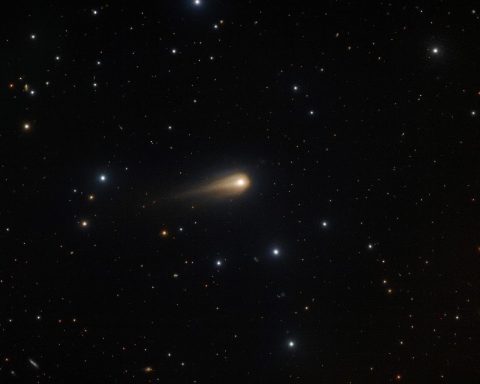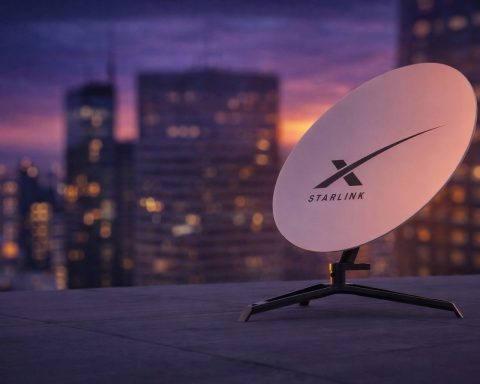- Key Facts: NASA’s Artemis II crew named their Orion capsule “Integrity” [1]; SpaceX launched 28 more Starlink satellites on Sept. 28 (booster B1063’s 28th flight) [2]. Europe’s ESA unveiled plans for a life-hunting mission to Saturn’s moon Enceladus [3] and rolled out “Pulse”, a new control system for all ESA satellites [4]. China on Sept. 27 launched its Fengyun-3H meteorology satellite for weather and climate monitoring [5]. Planet Labs announced a Berlin production site for its next-gen Pelican Earth-imaging satellites [6] [7]. NOAA signed off on a commercial prototype weather satellite (Stratus) [8]. The U.S. Space Force warned that China remains its top space threat [9], and Germany pledged $41B+ for military space upgrades (new sats, launch, cyber) [10]. (Astronomy Day on Sept. 27 encouraged stargazers to spot planets and deep-sky targets [11].)
Government Space Agency Missions & Announcements
NASA: In late September, NASA’s focus was on its upcoming Artemis II Moon mission. The four astronauts held a media briefing on Sept. 24 to announce the name of their Orion spacecraft: “Orion Integrity” [12]. They explained “Integrity” symbolizes the trust and collaboration needed for the mission. This 10-day crewed lunar test flight is slated for no later than April 2026. Meanwhile, NASA science made headlines with a major Mars discovery: analyses of a Perseverance rover sample (nicknamed “Sapphire Canyon”) from Jezero Crater suggest it “could preserve evidence of ancient microbial life” [13]. Acting NASA Administrator Sean Duffy called it “the closest we have ever come to discovering life on Mars,” calling the potential biosignature finding “groundbreaking” [14]. (This result, published Sept. 10 in Nature, stems from a 2024 sample of a “cheeselike” spotted rock.) These NASA findings underscore a busy month: Artemis II preparations, Mars science, and continued deep-space probes.
Also from NASA/NOAA: on Sept. 26 NOAA announced a partnership with Raytheon to study a new weather satellite design (the Stratus mission) under its NEON (Near Earth Orbit Network) program [15]. Irene Parker of NOAA said she was “excited for this new opportunity to use NOAA’s OTA [Other Transaction Authority] to advance weather imagery” with commercial partners [16]. The Stratus concept will field a small LEO satellite with an optical imager to test rapid-refresh cloud and storm monitoring. In summary, U.S. agencies are pushing forward on both exploration (Moon/Mars) and environmental observing.
ESA (Europe): European Space Agency leaders announced ambitious new projects. At the end of September ESA revealed “Pulse”, a mission-control system to unify monitoring and command of all ESA spacecraft [17]. According to ESA’s Katarzyna Cichecka, “Pulse is a foundational step towards an integrated, agile operational culture within ESA” [18]. This software-driven system will first support ESA’s Earth-observation Swarm satellites next year, then extend to all ESA missions, streamlining operations.
ESA also charted a bold new science mission: studying the moon Enceladus at Saturn, famed for its water-ice plumes. At a recent planetary science conference, ESA’s Jörn Helbert outlined a life-hunting mission to Enceladus [19]. Conceptually, two probes (an orbiter and a lander) would launch on Ariane-6 rockets in the early 2040s and arrive by the 2050s. Enceladus has liquid water, energy and organic materials — “three necessary conditions for supporting life” — so an ESA mission could directly sample its icy plumes for biosignatures [20]. (Helbert notes it may take decades of study to answer the life question, but Europe is now targeting the first steps.)
CNSA (China): China continued its fast pace of space activities. On Sept. 27 a Long March 4C rocket launched Fengyun-3H into sun-synchronous orbit from Jiuquan [21]. This polar-orbit weather satellite carries nine instruments (imagers and sounders) to improve global weather forecasting, atmospheric chemistry and climate monitoring [22] [23]. China calls it “Fengyun-3 08” or “3H,” part of its new-generation polar meteorology sats. Chinese state media noted this launch adds capacity for climate research and disaster warning [24]. (China has also been testing its next-generation rockets and lunar lander this year, gearing up for a 2030s crewed Moon program.)
Other Agencies: Russia’s Roscosmos has been quiet in this period, mainly supporting ISS cargo with Progress vehicles (the next Progress 93 was slated for early September). Japan’s JAXA and India’s ISRO had no major announcements on Sept. 27–28.
Commercial Launches, Partnerships & Tech
SpaceX/Starlink: In the commercial sector, SpaceX remained active. On Sept. 28, a SpaceX Falcon 9 lifted off from Vandenberg Space Force Base carrying 28 Starlink V2 Mini internet satellites [25]. This mission reused first-stage booster B1063 (in its 28th flight) and aimed for a landing on the “Of Course I Still Love You” droneship [26]. The launch bolsters Starlink’s low-orbit broadband constellation (now over 5,500 satellites launched so far). Meanwhile, SpaceX continued expanding Starlink capabilities: in mid-September it announced a $17 billion deal to buy S-band spectrum from EchoStar [27]. CEO Gwynne Shotwell noted that with this spectrum, Starlink will be able to deliver direct-to-cellular service (“ending mobile dead zones”) and increase capacity over 100-fold [28].
Blue Origin/New Glenn: Jeff Bezos’ Blue Origin moved ahead with its second flight of the New Glenn heavy rocket. Rocket Lab delivered NASA’s two ESCAPADE Mars probes (named “Blue” and “Gold”) to Florida for integration on New Glenn [29]. These twin satellites will launch to Mars on New Glenn in a late-September window (no earlier than fall) to study how Mars’ atmosphere interacts with the solar wind [30] [31]. In fact, Blue Origin originally targeted Sept. 29 for the launch of New Glenn’s second flight [32], carrying ESCAPADE; more recent reports suggest a brief slip into late October. The ESCAPADE mission is part of NASA’s small-sat SIMPLEx program (about $80M total) and will enter Mars orbit in 2027 to sample ions and fields [33]. In addition, Blue Origin successfully flew its 35th New Shepard suborbital rocket on Aug. 18 (NS-35), lofting 40+ research payloads including NASA student experiments [34]. Blue Origin VP Audrey Powers highlighted that “we’re proud to have flown hundreds of science, research, and educational payloads to space on New Shepard” [35], underscoring Blue Origin’s support for microgravity experiments and STEM programs.
Other Launch Providers: ULA launched another batch of Amazon’s Kuiper internet satellites on Sept. 26 (captured elsewhere), and Rocket Lab’s Electron remains active (had two launches earlier in September). Europe’s Arianespace is ramping up for Ariane-6’s debut (though first satellite launch is still targeted for early 2026).
Satellite Industry & Partnerships: The satellite industry saw several big deals. In Europe, Planet Labs announced it will invest a large sum to open a satellite factory in Berlin [36]. Under a German government–funded contract, Planet will build high-resolution Pelican Earth-imaging satellites in Germany, doubling its production capacity [37] [38]. CEO Will Marshall said the new Pelican satellites will “analyze images within minutes using AI” [39], a capability in demand for rapid intelligence (for example, Ukraine warfighters use real-time imagery). Breaking Defense notes this fits with Germany’s new space plans – Germany is funding €240M for Planet imagery and Planet “announced plans to begin production of next-generation…Pelican satellites in Germany” under an €<span style=”white-space:nowrap”>8-figure</span> investment [40]. Indeed, at a Sept. 25 conference Germany’s defense minister pledged €35 billion (~$41B) to boost military space [41]. He emphasized building new satellite constellations (for early warning, ISR, communications) and better cybersecurity [42], saying Germany must “effectively defend and deter in space” [43]. Part of that plan includes using companies like Planet and OHB (German launcher) to field new Earth-observation and comms satellites.
In other commercial news, Eutelsat-OneWeb expanded partnerships in Europe (and SpaceX dealt with new FCC tests for Starlink-for-aviation). Overall, the market is emphasizing space-based broadband (Starlink/Kuiper/OneWeb competition) and leveraging AI for imagery (Planet), while national policies (e.g. from Germany, France, the U.S.) channel funds into military and dual-use satellites.
Scientific Discoveries in Space
Alongside the news of hardware, September 27–28 saw exciting scientific results. Mars life signs: As noted, Perseverance’s Jezero Crater sample hinted at possible biosignatures [44]. Nicky Fox of NASA Science said this “identification of a potential biosignature on Mars is a groundbreaking discovery” [45]. Follow-up study continues as NASA plans to cache and eventually return Mars samples to Earth for more analysis (a step beyond this preliminary finding).
Astronomy Day: Sept. 27 was also International Astronomy Day, when amateur astronomers and educators highlight skywatching. NASA and astronomy clubs promoted observing guides. Space.com provided a Skywatching column noting “six stunning night sky objects to find” for Astronomy Day [46] (e.g. the Andromeda Galaxy, planets, or the ring of clear air by the Moon and Antares on that date [47]). This encouraged the public to enjoy telescopes and binoculars that weekend.
Astronomical Observations: While not specific to 9/27–28, other space telescopes were active this month. NASA’s Hubble Telescope released a new image of galaxy NGC 2775, an “anomalous” galaxy that blurs lines between spiral and lenticular types [48] [49]. The Hubble picture shows a dusty inner ring with star-forming tufts surrounded by a smooth central bulge [50] [51], puzzling astronomers and prompting theories about past galactic collisions. Such cosmic portraits remind us that even nearby galaxies can harbor surprises.
On the solar system front, ground-based observers track near-Earth asteroids, but no major impacts were reported. Infrared Telescope Facility in Hawaii and other observatories continued stellar surveys, but no “discovery news” with date stamps arose on 9/27–28.
Military/Defense Space News
Space remains a strategic domain. The U.S. Space Force leadership has been clear: China is their number-one space threat. In a Senate hearing Sept. 26, Lt. Gen. Stephen Schiess bluntly said China’s rapid satellite build-up (nearly 1,200 satellites orbiting by mid-2025) makes “China definitely our biggest threat” in space [52] [53]. The Chinese Communist Party has integrated space into its military strategy. This concern was echoed by Space Force Gen. B. Chance Saltzman, citing the need for resilient U.S. SATCOM and navigation in a contested environment.
In response, the U.S. Air Force and commercial partners are boosting capabilities. For example, the Air Force recently tapped Cubic Defense to develop HALO, an advanced multi-band SATCOM antenna [54]. HALO is software-defined and agnostic to host platforms (drones, jets, ships or planes), allowing forces to connect to satellites in LEO, MEO and GEO flexibly [55]. “By innovating the frequency-agile HALO ground antenna, we can better counter adversaries,” noted Cubic officials.
Elsewhere, NATO allies are also reinforcing space. As mentioned, Germany’s defense budget now earmarks tens of billions for space. Minister Pistorius warned that attacking satellites could “paralyze entire nations,” so Germany will build its own military satellite constellations [56]. This includes launching SARah radar recon sats (two of which launched in 2023) and planning two new comms satellites on Ariane 6 rockets [57] [58]. France similarly invests in defense satellites. Japan, Australia and others are expanding joint missile-warning and intel satellites.
Finally, commercial space startups are attracting defense interest. For example, Sierra Space (Dream Chaser maker) expects U.S. DOD contracts, and rocket companies (Relativity, Firefly) eye military launches. Overall, the two days’ news highlights how competition in space is heating up: governments now view space assets as potential targets and are mobilizing accordingly.
Climate & Earth Observation
Space-based Earth monitoring is in the spotlight due to extreme weather and climate needs. China’s new Fengyun-3H sat [59] will feed weather models for Asia-Pacific, aiding typhoon forecasts and climate science. Europe’s Copernicus program had already launched Sentinel-5A (for air quality) and is preparing land/ocean monitoring sats (though those launches happened earlier in Aug–Sep). New forecasts (via Copernicus climate bulletins) show August 2025 was one of the hottest on record.
In the U.S., NOAA’s NEON initiative (spurred by Congress) is fast-tracking small satellites. The Stratus effort [60] is a first step toward a new constellation of LEO weather-imagers (to augment NOAA’s traditional polar-orbit JPSS satellites). The idea is a resilient network of many small satellites with commercial design – a practice NOAA calls “buy-build-partner”. NOAA says an eventual NEON constellation will provide higher refresh rates for cloud/fog and fill gaps over the Arctic [61].
Commercial Earth-observation companies are also active. Planet’s Berlin expansion [62] [63] means higher cadence and resolution of imagery (helpful for climate science, disaster response, etc.). Companies like Spire and ICEYE continued launching storm/wildfire monitoring cubesats (e.g. the next Spire weather satellites by late-2025). In short, the space data pipeline for climate and weather is steadily growing.
Expert Insights: Space policy analysts emphasize these trends. Quilty Space Research notes Europe’s space push: “Germany’s big investment in national space systems” could shift Europe beyond its traditional reliance on France [64]. In the U.S., former NASA officials warn that public-private partnerships (like NASA’s CLPS lunar contracts) are yielding faster technology. Space scientist Nicky Fox hailed the Mars biosignature result as evidence that “strategic planning” of missions delivers exactly this type of science [65]. And defense experts like Dean Cheng of USIP comment that China’s achievements in rockets and landers are significant steps, urging the U.S. to maintain momentum [66] (GovTech coverage). Market analysts note that the Starlink-EchoStar deal is a huge bet on extending satellite broadband into the cellphone market [67], while observers of Blue Origin highlight that New Glenn’s debut and second flight could finally give Blue Origin a share of the heavy-lift launch market.
Looking Ahead: Forecasts suggest continued growth:
- Launch cadence is accelerating (2025 may set new records for orbital launches globally).
- Satellite constellations will proliferate (telecom, IoT, LEO imagery) – analysts predict tens of thousands of active satellites by 2030.
- Commercial crew & tourism will resume (Blue Origin’s next New Shepard passenger flight is already scheduled for Oct 2025).
- Mega-constellations (Starlink, Kuiper, OneWeb) are talking to regulators about extending coverage (as oneNet, etc.).
Space industry investors see a bright future but caution on space traffic management and cybersecurity. The global space economy was recently valued at ~$550 billion and is expected to double by the end of the decade. Governments meanwhile will likely raise space budgets (the U.S. space budget request for 2026 is climbing again).
Sources: Official agency press releases and news reports from Sept. 27–28, 2025, including NASA, ESA, China’s Xinhua, Spaceflight Now, Space.com, Reuters, Breaking Defense, etc. (See citations above for details of each item.)
References
1. www.nasa.gov, 2. spaceflightnow.com, 3. www.space.com, 4. www.esa.int, 5. global.chinadaily.com.cn, 6. www.reuters.com, 7. breakingdefense.com, 8. www.nesdis.noaa.gov, 9. www.defensenews.com, 10. breakingdefense.com, 11. www.space.com, 12. www.nasa.gov, 13. www.nasa.gov, 14. www.nasa.gov, 15. www.nesdis.noaa.gov, 16. www.nesdis.noaa.gov, 17. www.esa.int, 18. www.esa.int, 19. www.space.com, 20. www.space.com, 21. global.chinadaily.com.cn, 22. global.chinadaily.com.cn, 23. en.people.cn, 24. global.chinadaily.com.cn, 25. spaceflightnow.com, 26. spaceflightnow.com, 27. www.reuters.com, 28. www.reuters.com, 29. www.space.com, 30. www.space.com, 31. www.space.com, 32. spacepolicyonline.com, 33. www.space.com, 34. www.blueorigin.com, 35. www.blueorigin.com, 36. www.reuters.com, 37. www.reuters.com, 38. breakingdefense.com, 39. www.reuters.com, 40. breakingdefense.com, 41. breakingdefense.com, 42. breakingdefense.com, 43. breakingdefense.com, 44. www.nasa.gov, 45. www.nasa.gov, 46. www.space.com, 47. www.space.com, 48. science.nasa.gov, 49. science.nasa.gov, 50. science.nasa.gov, 51. science.nasa.gov, 52. www.defensenews.com, 53. www.defensenews.com, 54. thedefensepost.com, 55. thedefensepost.com, 56. breakingdefense.com, 57. breakingdefense.com, 58. breakingdefense.com, 59. global.chinadaily.com.cn, 60. www.nesdis.noaa.gov, 61. www.nesdis.noaa.gov, 62. www.reuters.com, 63. breakingdefense.com, 64. breakingdefense.com, 65. www.nasa.gov, 66. www.govtech.com, 67. www.reuters.com










